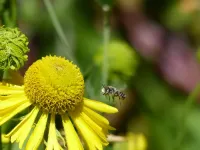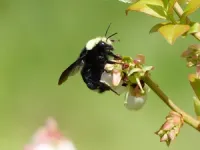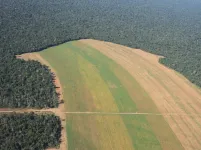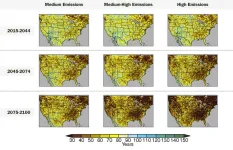(Press-News.org) CORVALLIS, Ore. – Native bees in the Oregon Coast Range are diverse and abundant in clearcut areas within a few years of timber harvest but their numbers drop sharply as planted trees grow and the forest canopy closes, research by Oregon State University shows.
The findings are important for understanding the roles forest management might play in the conservation of a crucial pollinator group, the researchers said.
The study, led by graduate student Rachel Zitomer and Jim Rivers, an animal ecologist in the OSU College of Forestry, was published in Ecological Applications.
“The research demonstrates that Douglas-fir plantations develop diverse communities of wild bees shortly after harvest,” Rivers said. “Management activities that promote open conditions and enhance floral resources in the initial years following harvest are likely to promote bee diversity in intensively managed forest landscapes.”
Despite widespread concern about how human activity may be driving global declines in pollinator species, little is known about the impacts of land management practices on wild bees outside of agricultural systems, the scientists note.
Closing that knowledge gap is critical, they say, because bees pollinate many of the flowering plants that make up ecosystems and support food webs.
In the spring and summer of 2018 and 2019, the scientists looked at native bee communities in 60 Douglas-fir stands of varying ages across a time frame representative of a typical 40-year harvest rotation.
The authors found that the total number of bees and the number of different bee species declined markedly with stand age, falling an average of 61% and 48%, respectively, for each five-year increment after harvest.
“Our results are important for forest managers because they indicate that bees do use intensively harvested stands, and that the window for bee conservation measures is restricted to a relatively short time period,” Zitomer said. “Our research is one of the first attempts to quantify how native bee communities change over time after one of the dominant forest disturbances that take place in the Oregon Coast Range.”
Animal pollinators enhance the reproduction of nearly 90% of the Earth’s flowering plants, including many food crops, and are an essential component of insect and plant biodiversity. Native insect pollinators, primarily bees, are estimated to contribute more than $3 billion per year in commercial pollination services in the United States, Zitomer said, and are essential for the functioning of natural ecosystems and food chains. Oregon is home to more than 600 species of native bees, and nearly a quarter of them are found in recently harvested forests.
“Wild bees are the top pollinators in most temperate regions, and widespread declines have prompted worries about food security as well as ecosystem function,” Rivers said. “Understanding bees’ habitat requirements and how they respond to human activity is imperative if we want to take effective conservation measures.”
Recent studies have indicated that moderately reducing the application of herbicides in the initial years after harvest can enhance pollinator species richness, in some cases without compromising revenue potential, the authors say.
“That could be a win-win for timber production and biodiversity conservation,” Zitomer said.
Including bee-pollinated plant species in the seed mixes used for revegetation along roadsides and at log landings is another way to help ensure maximum bee presence after timber harvesting, the researchers note. A landing is where logs are placed prior to loading on trucks.
The U.S. Department of Agriculture and Food Research Initiative and a National Science Foundation Graduate Research Fellowship funded this study.
Also taking part in the research were Matthew Betts of the OSU College of Forestry, Andrew Moldenke of the OSU College of Agricultural Sciences, Sara Galbraith of Colorado State University and Robert Progar of the U.S. Forest Service.
END
Bees flock to clearcut areas but numbers decline as forest canopy regrows, OSU research shows
2023-04-13
ELSE PRESS RELEASES FROM THIS DATE:
Global study finds some women experience heavier menstrual flow after COVID-19 vaccination
2023-04-13
A new international study finds that women vaccinated for COVID-19 have a slightly higher risk for a heavier period after vaccination.
The study, led by Oregon Health & Science University reproductive health services researcher Blair Darney, Ph.D., M.P.H., and physician-scientist Alison Edelman, M.D., M.P.H., published today in the British Journal of Obstetrics and Gynaecology. These findings build on prior work from the same research team that first identified an association between COVID-19 vaccines ...
Virtual fitting rooms can be a double-edged sword
2023-04-13
AMES, IA – Driven by online shopping, a growing number of retailers have launched virtual fitting rooms in recent years. That includes Amazon, the top apparel seller in the U.S., along with Nike, Macy’s and Walmart. The virtual rooms allow shoppers to ‘try on’ clothes through interactive simulation technology and texture-mapped product images. It can cut down on returns and nudge hesitant shoppers to click the checkout button.
But findings from a recently published study indicate virtual fitting rooms could backfire on retailers if they assume ...
Low-professionalism residents later draw higher patient complaints: Study
2023-04-13
The first study to examine evaluation scores for professionalism and interpersonal communication skills among physicians-in-training and what happens afterward as these doctors begin their practice is reported in JAMA Network Open. The study tracked 9,340 early-career physicians from across the country.
The study finds a strong association between lower ratings for these competencies among residents in their last year of training and greater likelihood of unsolicited patient complaints among doctors during their first year of employment ...
Journal of Neuromuscular Diseases transitioning to Gold Open Access in 2023
2023-04-13
Amsterdam, April 13, 2023 – The Journal of Neuromuscular Diseases (JND), published by IOS Press, is pleased to announce that from July 1, 2023 (Volume 10, Issue 4), the journal will transition to a Gold Open Access publication. This means that all articles published after that date will be immediately and permanently freely available online for readers to view, download, share, and reuse, and will enable authors to more easily comply with funder and institutional mandates.
“When JND launched almost 10 years ago, among our primary goals was and continues to ...
COVID lockdown allows study of tourism’s impact on Hawaii fishes
2023-04-13
During August 2019, more than 40,000 tourists visited Hawaii’s Molokini island to snorkel or dive. In March 2020 the worldwide COVID lockdown dropped that number to zero.
The sudden and prolonged drop in visitors to one of the world’s most popular snorkeling spots provided scientists with a novel opportunity to study how underwater tourism impacts marine fishes. The results of their study, published in the most recent issue of PLOS One, will help resource managers better care for Molokini and other threatened marine habitats.
The study’s lead author, Dr. Kevin Weng of William & Mary’s Virginia Institute of Marine Science, ...
Researchers find earlier intervention leads to greater improvements in young children on the autism spectrum
2023-04-13
Researchers from Children’s Hospital of Philadelphia (CHOP), Florida State University (FSU), and the University of California, Los Angeles (UCLA) have demonstrated that starting intervention coaching parents of autistic toddlers as early as 18 months leads to better gains in language, social communication, and daily living skills.
Their findings were recently published in the journal Autism.
While prior studies provided strong evidence for the benefits of early intervention in autism, many are correlation studies rather than randomized controlled studies that ...
Private lands stalling Brazil’s conservation efforts
2023-04-13
As Brazil seeks ways to protect its crucial Amazon Forest, a new study shows that excusing private landowners from conserving their precious land has come at a steep cost to global sustainability.
In this week’s Nature Communications Earth & Environment, scientists at Michigan State University’s Center for Systems Integration and Sustainability (MSU-CSIS) as well as Brazil and the UK found that since 2012 more than half of the deforestation in the Brazilian Amazon has taken place on designated private conservation areas within rural private properties. However, ...
Hairs that help fish feel–and humans hear
2023-04-13
CLEVELAND–By discovering how zebrafish use their hair cells to detect distant movement, a team of Case Western Reserve scientists may have found a path to help explain human hearing loss.
Even though the tiny water creatures and humans would appear to have nothing in common, the structure and function of the hair cells on zebrafish skin are nearly identical to cochlear hair cells found in the human inner ear.
In addition, both the fish and human cell receptors have a type of protein known as an “ion channel,” which converts the waves that the cells detect into electrical impulses that carry useful information.
However, in humans, ...
Wildfires and animal biodiversity
2023-04-13
Wildfires. Many see them as purely destructive forces, disasters that blaze through a landscape, charring everything in their paths. But a study published in the journal Ecology Letters reminds us that wildfires are also generative forces, spurring biodiversity in their wakes.
“There’s a fair amount of biodiversity research on fire and plants,” said Max Moritz, a wildfire specialist with UC CooperativeExtension who is based at UC Santa Barbara’s Bren School of Environmental Science & Management, and is the study’s lead author. Research has shown that in ecosystems where fire is a natural and regular occurrence, there ...
New look at climate data shows substantially wetter rain and snow days ahead
2023-04-13
A key source of information underpinning the upcoming National Climate Assessment suggests that heavy precipitation days historically experienced once in a century by Americans could in the future be experienced on several occasions in a lifetime.
Scientists at Scripps Institution of Oceanography at UC San Diego and the Department of Energy’s Lawrence Berkeley National Laboratory (Berkeley Lab) report that extremely intense days of rain or snow will be more frequent by the end of this century than previously thought ...








